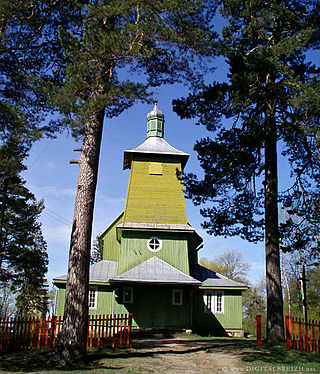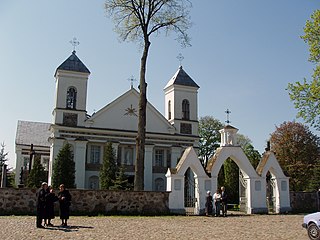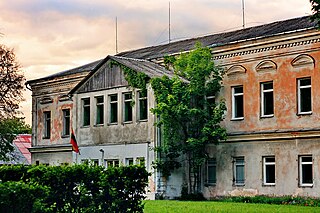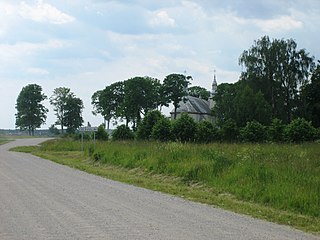
A seniūnija is the smallest administrative division of Lithuania. An eldership may comprise a very small region consisting of few villages, one single town, or a part of a big city. Elderships vary in size and population depending on their location and nature. A few elderships make up a municipality. Šilainiai (Kaunas), Dainava (Kaunas) and Verkiai (Vilnius) are the most populous elderates, with population counts over 50,000, exceeding the population of some entire municipalities.

Vilnius Region is the territory in present-day Lithuania and Belarus that was originally inhabited by ethnic Baltic tribes and was a part of Lithuania proper, but came under East Slavic and Polish cultural influences over time.

This article is about the administrative divisions of Lithuania.

Vilnius District Municipality is one of 60 municipalities in Lithuania. It surrounds the capital city of Vilnius on 3 sides, while the rest borders the Trakai District Municipality.

Eišiškės is a small city in southeastern Lithuania on the border with Belarus. It is situated on a small group of hills, surrounded by marshy valley of Verseka and Dumblė Rivers. The rivers divide the town into two parts; the northern part is called Jurzdika. As of the census in 2011, Eišiškės had a population of 3,416. It has a hospital and two high schools.

Švenčionys is the town, located 84 kilometers (52 mi) north of Vilnius in Lithuania. It is the capital of the Švenčionys district municipality. As of 2020, it had population of 4,065 of which about 17% is part of the Polish minority in Lithuania.

Astikai was a Lithuanian noble family, that prospered in late 14th and early 17th centuries. Kristinas Astikas, a noble from Kernavė, was the founder of the family. There is some vague evidence, that his father was Sirputis and his grandfather was Viršulis, mentioned in chronicles. It is worth to note, that members of Astikai family on different occasions were referred to by these names. One of treaties signed by Kristinas Astikas mentions his father name, Radvilas. However, that is the only reliable clue into the genealogy of Astikai family.

Radvila Astikas or Astikaitis was a magnate, a member of the Astikai and founder of the Radvila (Radziwiłł) family. He was a member of the Lithuanian Council of Lords and one of the most influential people in the Grand Duchy of Lithuania.

Norviliškės is a small village in the so-called Dieveniškės appendix, Šalčininkai district municipality, Lithuania. It is located about 12 km (7.5 mi) northeast of the town of Dieveniškės near the border with Belarus. In 1986 it had 58 residents, and 20 residents in 2011.
Migonys is a village in the Kupiškis district municipality, Lithuania. According to the 2011 census, it had 106 inhabitants. The village celebrated its 400th anniversary in 1924. There is a hill-fort and 36 tumuli in the vicinity of the village.

Hinduism is a minority religion and a fairly recent development in Lithuania. Hinduism is spread in Lithuania by Hindu organizations: ISKCON, Sathya Sai Baba, Brahma Kumaris and Osho Rajneesh. As of 2015, there were 580 (0.02%) Hindus in Lithuania.

The Supreme Soviet of the Lithuanian SSR was the supreme soviet of the Lithuanian SSR, one of the republics constituting the Soviet Union. The Supreme Soviet was established in August 1940 when the People's Seimas declared itself the provisional Supreme Soviet. According to the constitution it was very similar to modern democratic parliaments: it was elected every four years and had the power to create, amend and ratify the constitution, laws, and treaties and appoint officials in the Council of Ministers. However, in reality the elections were staged, the Soviet had very little actual power and carried out orders given by the Communist Party of Lithuania (CPL). The situation changed in 1988, when the Lithuanians began seeking independence from the Soviet Union. The political power shifted from CPL to the Soviet, which adopted a number of important constitutional amendments and laws, paving the way for the independence. The first free elections were held in February 1990 and were won by pro-independence Sąjūdis. During its first session the Supreme Soviet adopted the Act of the Re-Establishment of the State of Lithuania and renamed itself the Supreme Council of the Republic of Lithuania.

Valkininkai is a historic town in Valkininkų (Valkininkai) eldership, Varėna District Municipality, Alytus County, Lithuania, located about 22 km (14 mi) northeast from Varėna and about 55 km (34 mi) southwest from Vilnius. At the Lithuanian census of 2001, its population was 238 and at the census of 2011 it was 229.

Rudamina is a small town in Alytus County in southern Lithuania. As of 2011 it had a population of 256. Rudamina hill fort, one of the most prominent hill forts of ancient Yotvingians, is located about 1 km southwest of the town. Nearby tumuli were dated to 3rd–4th century AD. The town traces its history to 1576 when Massalski family established an estate and began cutting down the forest. In 1592, the Massalkis built a Catholic church; the present-day church was built in the 1770s. The town received Magdeburg rights in the early 17th century. However, Rudamina never grew larger as it was overshadowed by nearby Lazdijai and Šeštokai with its train station. Its population was 269 in 1800, 256 in 1923, 329 in 1959, 367 in 1979.

Šventežeris is a small town in Alytus County in southern Lithuania. As of 2011 it had a population of 295. It is situated some 8 kilometres (5.0 mi) east of Lazdijai on the banks of Lake Šventežeris.

Jašiūnai is a town in Lithuania. It is situated on the Merkys River and an edge of the Rūdninkai Forest. According to the 2001 census, it had population of 1,879. The town's population is primarily Poles, with Lithuanians (12,4%) and Russians (8,4%).

Buivydiškės is a village in Vilnius district municipality, Lithuania. According to the 2011 census, it had 1,314 residents. Buivydiškės Manor was first mentioned in 1593. The village has a technical school for agronomy and zootechnics, established in 1961. The school helped the village to grow from 190 residents in 1959 to 1,265 in 1970. Buivydiškės became a suburb of expanding Vilnius, capital of Lithuania. In 1996, part of the settlement was transferred to Vilnius city municipality.

Saldutiškis is a small town in northeastern Lithuania. According to the Lithuanian census of 2011, it had 343 residents.

Šešuoliai is a small town in central Lithuania. It is located just east of the Lake Šešuoliai. According to the Lithuanian census of 2011, it had 138 residents. The town's central square and street layout is protected as an urban monument.
The Council of Ministers of the Lithuanian SSR or Council of People's Commissars in 1940–46 was the cabinet of the Lithuanian SSR, one of the republics of the Soviet Union. Its structure and functions were modeled after the Council of People's Commissars and Council of Ministers of the Soviet Union. The Council consisted of a chairman, first vice-chairman, vice-chairmen, ministers, and chairmen of state committees. The council's chairman was equivalent to a prime minister and was second in rank after the First Secretary of the Communist Party of Lithuania.





















